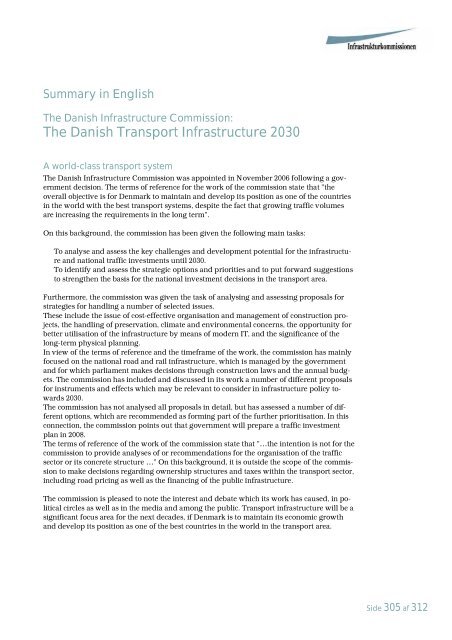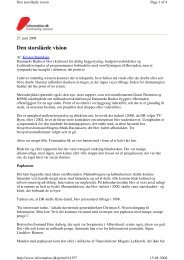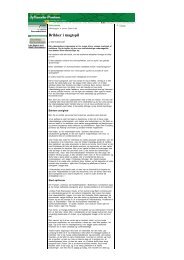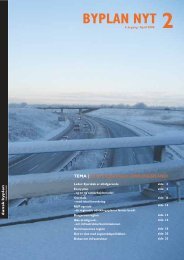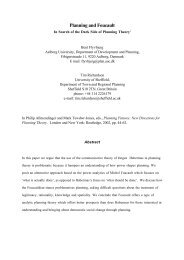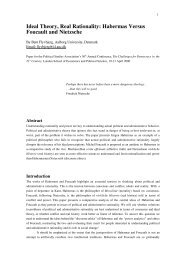- Page 1 and 2:
Danmarks Transportinfrastruktur 203
- Page 3 and 4:
Danmarks transportinfrastruktur 203
- Page 5 and 6:
Indhold Indhold ...................
- Page 7 and 8:
13.5. Sammenhæng i hovedstadens pl
- Page 9 and 10:
Andre faglige dokumenter De i bilag
- Page 11 and 12:
Indledning Infrastrukturkommissione
- Page 13 and 14:
Kommissionens medlemmer Kommissione
- Page 15 and 16:
Kommissionens betænkning Kommissio
- Page 17 and 18:
DEL 1: DAGENS INFRASTRUKTUR Side 15
- Page 19 and 20:
Kapitel 1. Transportinfrastrukturen
- Page 21 and 22:
Samtidig har Danmark en række havn
- Page 23 and 24:
Figur 1.2a Statsvejnettet pr. 1. ja
- Page 25 and 26:
Figur 1.3 Vejstandarder på statsve
- Page 27 and 28:
Tabel 1.4 Banenettets udstrækning
- Page 29 and 30:
De resterende to tredjedele af nett
- Page 31 and 32:
Der er i dag et stort antal interna
- Page 33 and 34:
Figur 1.7 Udviklingen i trafikarbej
- Page 35 and 36:
Tabel 1.6 Procentvis fordeling af i
- Page 37 and 38:
Figur 1.10 Kapacitetsudnyttelsen p
- Page 39 and 40:
sammenlignet, mens det for de 3 kor
- Page 41 and 42:
På strækninger markeret med rødt
- Page 43 and 44:
Figur 1.12 Udviklingen i emissioner
- Page 45 and 46:
1.4.3. Trafiksikkerhed Der har i Da
- Page 47 and 48:
gevægt mellem den almindelige nedb
- Page 49 and 50:
Tabel 1.12 Igangværende og beslutt
- Page 51 and 52:
Etablering eller forbedring af eksi
- Page 53 and 54:
For en række projekter er anført,
- Page 55 and 56:
Figur 1.15 Cityringens linieføring
- Page 57 and 58:
Kapitel 2. Hvem ejer og regulerer i
- Page 59 and 60:
Med loven om jernbanevirksomhed fra
- Page 61 and 62:
til at sikre, at lufttrafik udgør
- Page 63 and 64:
Figur 2.2 Organiseringen af persont
- Page 65 and 66:
2.2.1. Beslutningsprocedure for anl
- Page 67 and 68:
Reformen indebærer, at usikkerheds
- Page 69 and 70:
Når VVM-undersøgelsen er gennemf
- Page 71 and 72:
Kapitel 3. Infrastrukturen og samsp
- Page 73 and 74:
cykler og biler ved stationerne, me
- Page 75 and 76:
Der vil formentlig bl.a. løbende b
- Page 77 and 78:
Et transportknudepunkt kan således
- Page 79 and 80:
Boks 3.6 Eksempel på samspil - Kø
- Page 81 and 82:
Boks 3.7 Eksempel på samspil - Bel
- Page 83 and 84:
Kapitel 4. Transportinfrastrukturen
- Page 85 and 86:
Figur 4.1 Vejanlægsinvesteringer e
- Page 87 and 88:
Figur 4.3 Fordeling af Banedanmarks
- Page 89 and 90:
Figur 4.5 Den regionale fordeling a
- Page 91 and 92:
Tabel 4.4 Samlede afgifter af motor
- Page 93 and 94:
Afgift af benzin Afgiften af benzin
- Page 95 and 96:
Trafikindtægter på statens banene
- Page 97 and 98:
I 2006 var vederlaget fra Banedanma
- Page 99 and 100:
Kapitel 5. Dansk transport og infra
- Page 101 and 102:
5.2.1. Transport af personer Figur
- Page 103 and 104:
Figur 5.3 Antal dræbte på vejene
- Page 105 and 106:
Mens hvidbogen fra 2001 var fokuser
- Page 107 and 108:
videt adgang til logistik-styring m
- Page 109 and 110:
dialog mellem lufthavne og luftfart
- Page 111 and 112:
Processen er præget af en række m
- Page 113 and 114:
DEL 2: HVAD PÅVIRKER KRAVENE TIL F
- Page 115 and 116:
Kapitel 6. Hvad bestemmer udvikling
- Page 117 and 118:
En analyse af sammenhængen mellem
- Page 119 and 120:
Figur 6.4 Pendlingsregioner i Danma
- Page 121 and 122:
Boks 6.1Sammenhænge og udviklingst
- Page 123 and 124:
6.4. Livsstilsrelaterede faktorer E
- Page 125 and 126:
Der vil således blive efterspurgt
- Page 127 and 128:
Kapitel 7. Fremskrivning af trafikk
- Page 129 and 130:
Boks 7.1 Danmarks TransportForsknin
- Page 131 and 132:
Figur 7.1 Trafikken i et gennemsnit
- Page 133 and 134:
7.2.1. Trængsel Der er allerede i
- Page 135 and 136:
Trængselsforhold på de enkelte st
- Page 137 and 138:
kan forventes, at begyndende træng
- Page 139 and 140:
7.3. Fremskrivning af persontrafik
- Page 141 and 142:
Metroen i København er et relativt
- Page 143 and 144:
kan forventes lidt højere vækstra
- Page 145 and 146:
Figur 7.10 Udvikling i den årlige
- Page 147 and 148:
Figur 7.11 Togrejser i Storbritanni
- Page 149 and 150:
7.6.2. Følsomhed af indkomstelasti
- Page 151 and 152:
Effekten af denne ændring kan ses
- Page 153 and 154:
Kapitel 8. Infrastrukturens betydni
- Page 155 and 156:
Størrelsen af det lokale arbejdsma
- Page 157 and 158:
Transportministeriet gennemfører s
- Page 159 and 160:
Millioner 2005 kr. Udbygning af eks
- Page 161 and 162:
Ganske mange faktorer værdisættes
- Page 163 and 164:
Det faglige rationale bag at operer
- Page 165 and 166:
Kapitel 9. Miljø, klima og transpo
- Page 167 and 168:
9.2.1. Den nationale udfordring Dri
- Page 169 and 170:
Disse stoffer har forskellige egens
- Page 171 and 172:
Figur 9.2 Udviklingen i emissioner
- Page 173 and 174:
1988, svarer dette til næsten en h
- Page 175 and 176:
Den europæiske transportministerko
- Page 177 and 178:
Kommissionen finder, at Danmark gen
- Page 179 and 180:
• Forbedring af transportens ener
- Page 181 and 182:
Boks 9.5 Beskrivelse af måleenhede
- Page 183 and 184:
trafik vil foranstaltninger til dæ
- Page 185 and 186:
DEL 3: UDFORDRINGER OG UDVIKLINGSMU
- Page 187 and 188:
Kapitel 10. Centrale udfordringer f
- Page 189 and 190:
fungerende, pålideligt transportsy
- Page 191 and 192:
I et perspektiv frem mod 2030 vil o
- Page 193 and 194:
Kapitel 11. Teknologiudviklingens b
- Page 195 and 196:
Det største potentiale for anvende
- Page 197 and 198:
Samspillet mellem infrastrukturen o
- Page 199 and 200:
I en række udenlandske storbyer er
- Page 201 and 202:
• Displays med næste stop i buss
- Page 203 and 204:
myldretiderne til kørespor. Ved
- Page 205 and 206:
Der vil også være en hastig udvik
- Page 207 and 208:
findes allerede, og med yderligere
- Page 209 and 210:
Kapitel 12. Organisering og styring
- Page 211 and 212:
Totalentreprise-modellen kan medfø
- Page 213 and 214:
OPP-konstruktionen fungerer oftest
- Page 215 and 216:
Ved valg af betalingsform er det vi
- Page 217 and 218:
• Egnede opgaver udføres om natt
- Page 219 and 220:
En betydelig del af arbejdsopgavern
- Page 221 and 222:
Boks 12.6 Engelske empiriske result
- Page 223 and 224:
I de modeller, der indebærer en sa
- Page 225 and 226:
Boks 12.8 Udbudsformer • Konkurre
- Page 227 and 228:
Kapitel 13. Infrastruktur, byudvikl
- Page 229 and 230:
Udgangspunktet for planlægningen e
- Page 231 and 232:
napassager og landskabsbroer, der b
- Page 233 and 234:
Nogle erhverv kan hensigtsmæssigt
- Page 235 and 236:
Boks 13.6 Igangværende undersøgel
- Page 237 and 238:
Desuden fastsætter Fingerplan 2007
- Page 239 and 240:
Kapitel 14. Investeringsplanlægnin
- Page 241 and 242:
Mindre anlægsforbedringer er kende
- Page 243 and 244:
tionen. Investeringer i forhøjelse
- Page 245 and 246:
Figur 14.1 Langsigtet planlægning
- Page 247 and 248:
Boks 14.2 De største projekter i T
- Page 249 and 250:
14.5.1. Trafikmodeller I et typisk
- Page 251 and 252:
14.5.3. Investeringsplanlægning Ud
- Page 253 and 254:
Kategoriseringen skal tages med det
- Page 255 and 256: Med løfter som følge af aftalen o
- Page 257 and 258: Kapitel 15. Internationale erfaring
- Page 259 and 260: ge foretages typisk med fire års m
- Page 261 and 262: ger under havets overflade. Landet
- Page 263 and 264: Boks 15.2 Vurdering af konsekvenser
- Page 265 and 266: Boks 15.7 Politiske mål i the Mobi
- Page 267 and 268: 15.3. Perspektiver for transportpol
- Page 269 and 270: Boks 15.11 Udvalgt materiale til CO
- Page 271 and 272: ken. Hermed kan det f.eks. undgås,
- Page 273 and 274: DEL 4: VISIONER OG STRATEGIER FOR I
- Page 275 and 276: Kapitel 16. Vision, målsætninger
- Page 277 and 278: • De teknologiske muligheder for
- Page 279 and 280: Det fremgår af regeringsgrundlaget
- Page 281 and 282: Det er vigtigt, at investeringsinds
- Page 283 and 284: Køge og en udbygning med et 5. spo
- Page 285 and 286: 16.3.2. En samlet plan for udviklin
- Page 287 and 288: Figur 16.5 Direkte bane Odense-Hors
- Page 289 and 290: Der vil typisk være tale om - rela
- Page 291 and 292: • Forbedret viden og information
- Page 293 and 294: Kapitel 17. Anbefalinger om instrum
- Page 295 and 296: En investeringsindsats koncentreret
- Page 297 and 298: Samspil Infrastrukturkommissionen a
- Page 299 and 300: 17.2.3. Effektiv opkobling af de en
- Page 301 and 302: Boks 17.6 Anbefalinger vedr. intell
- Page 303 and 304: Boks 17.8 Anbefalinger vedrørende
- Page 305: Kommissionen noterer sig, at Færds
- Page 309 and 310: International surveys place the Dan
- Page 311 and 312: • with due diligence, a productiv
- Page 313 and 314: Ordforklaringer Cost-benefit analys


